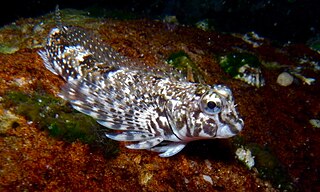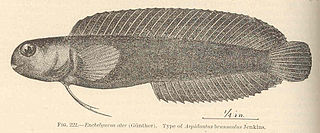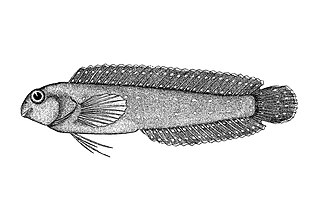
Combtooth blennies are blenniiformids; percomorph marine fish of the family Blenniidae, part of the order Blenniiformes. They are the largest family of blennies with around 401 known species in 58 generas. Combtooth blennies are found in tropical and subtropical waters in the Atlantic, Pacific and Indian Oceans; some species are also found in brackish and even freshwater environments.

Labrisomids are small blennioids (blennies), percomorph marine fish belonging to the family Labrisomidae. Found mostly in the tropical Atlantic and Pacific Ocean, the family contains about 110 species in 15 genera.

Blenny is a common name for a type of fish. The term is ambiguous, having been applied to several families of percomorph marine, brackish, and some freshwater fish sharing similar morphology and behaviour. Six families are considered "true blennies", all grouped together under the order Blenniiformes; its members are referred to as blenniiformids. About 151 genera and nearly 900 species have been described within the order. The order was formerly classified as a suborder of the Perciformes but the 5th Edition of Fishes of the World divided the Perciformes into a number of new orders and the Blenniiformes were placed in the percomorph clade Ovalentaria alongside the such taxa as Cichliformes, Mugiliformes and Gobiesociformes.

Lepidoblennius is a genus of triplefins in the family Tripterygiidae. Both species occur in Australia.

Blennius is a Genus of combtooth blenny in the family Blenniidae. Its members include Blennius ocellaris, the Butterfly Blenny.

Salarias is a genus of combtooth blennies found in the Indian and Pacific oceans.

Ecsenius is a large genus of fish in the family Blenniidae.

Cirripectes is a large genus of combtooth blennies found throughout the Pacific and Indian oceans.
Chalaroderma capito, the looseskin blenny, is a species of combtooth blenny found in the south Atlantic ocean where it is found from Saldanha Bay to East London in South Africa. This species reaches a length of 20 centimetres (7.9 in) SL.

Chalaroderma ocellata, the two-eyed blenny, is a species of combtooth blenny found in the southeast Atlantic ocean where it is known only from Saldanha Bay to Port Elizabeth in South Africa. This species reaches a length of 7 centimetres (2.8 in) SL.

Enchelyurus is a genus of combtooth blennies found in the Pacific and Indian Oceans.

Hypleurochilus is a genus of combtooth blennies found throughout the Atlantic Ocean.
Omox is a small genus of combtooth blennies found in the western Pacific Ocean.

Parenchelyurus is a genus of combtooth blennies found in the Pacific, and Indian oceans.
Ecsenius lividanalis, known commonly as the blue-head combtooth-blenny in Indonesia and also known as the blue-headed combtooth blenny, is a species of combtooth blenny in the genus Ecsenius. It is found in coral reefs throughout the western Pacific ocean. It can reach a maximum length of 5 centimetres. Blennies in this species feed primarily off of plants, including benthic algae and weeds, and are commercial aquarium fish. There are two colour forms of this blenny, both of which have a black spot around the anus. One form has a blue head with a yellow body and iris while the other form is dark, occasionally all yellow, with a bluish-white iris, a yellow back and a yellow caudal fin.
Emblemaria is a genus of chaenopsid blennies found throughout the Pacific and Atlantic oceans.

Emblemariopsis is a genus of flagblennies found throughout the Atlantic ocean.

Emblemariopsis diaphana, the glass blenny, is a species of chaenopsid blenny found in coral reefs in the Florida Keys, USA, in the western central Atlantic ocean. It can reach a maximum length of 4 centimetres (1.6 in) TL. The specific name refers to this species being "largely translucent" in life, although this is lost in preserved specimens. E. diaphana is the type species of the genus Emblemariopsis.

Exerpes asper, the Sargassum blenny, is a species of labrisomid blenny native to the Gulf of California and the Pacific coast of Baja California. According to Fishbase it is currently the only known member of its genus, however, the Catalog of Fishes classifies it within the genus Paraclinus.

Starksia is a genus of labrisomid blennies native to the western Atlantic Ocean and the eastern Pacific Ocean. Their typical length is 2 cm (0.79 in) SL. The generic name honours the American ichthyologist Edwin Chapin Starks (1867-1932) of Stanford University for his work on Pacific coastal fishes. As a genus Starksia is distinguished from other labrisomids by their scaled bodies, two obvious soft rays in the pelvic fin and the male's have an intromittent organ which is near to or attached to the first spine of their anal fins, which is also somewhat separated from the fin.















